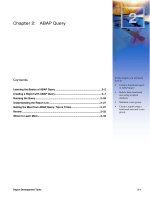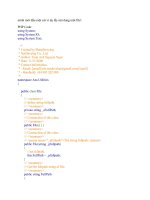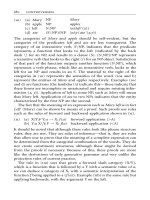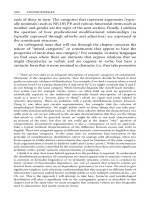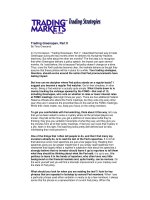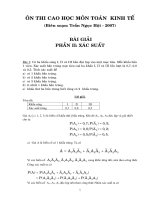Tài liệu CNNA3-Chapter 2: Part II pdf
Bạn đang xem bản rút gọn của tài liệu. Xem và tải ngay bản đầy đủ của tài liệu tại đây (732.32 KB, 30 trang )
CCNA3-1
Chapter 2-2
Chapter 2
Chapter 2
Switch Concepts and
Switch Concepts and
Configuration
Configuration
Part II
Part II
CCNA3-2
Chapter 2-2
Switch Concepts and Configuration
Switch Concepts and Configuration
Configuring Switch Security
Configuring Switch Security
Passwords
Passwords
Passwords
Passwords
Encryption
Encryption
Encryption
Encryption
Console
Console
Console
Console
Telnet / SSH
Telnet / SSH
Telnet / SSH
Telnet / SSH
Password Recovery
Password Recovery
Password Recovery
Password Recovery
MAC Address Flooding
MAC Address Flooding
MAC Address Flooding
MAC Address Flooding
Spoofing Attacks
Spoofing Attacks
Spoofing Attacks
Spoofing Attacks
CDP Attacks
CDP Attacks
CDP Attacks
CDP Attacks
Telnet Attacks
Telnet Attacks
Telnet Attacks
Telnet Attacks
Security Tools
Security Tools
Security Tools
Security Tools
Port Security
Port Security
Port Security
Port Security
CCNA3-3
Chapter 2-2
•
Securing Console Access:
Securing Console Access:
Configuring Password Options
Configuring Password Options
CCNA3-4
Chapter 2-2
•
Securing Virtual Terminal Access:
Securing Virtual Terminal Access:
•
There are 16 available default Telnet sessions as
There are 16 available default Telnet sessions as
opposed to the 5 sessions set up for a router.
opposed to the 5 sessions set up for a router.
Configuring Password Options
Configuring Password Options
CCNA3-5
Chapter 2-2
•
Securing Privileged EXEC Access:
Securing Privileged EXEC Access:
•
Always use
Always use
enable secret
enable secret
for password encryption.
for password encryption.
Configuring Password Options
Configuring Password Options
CCNA3-6
Chapter 2-2
•
Encrypting Switch Passwords:
Encrypting Switch Passwords:
•
You can encrypt all passwords assigned to a switch using
You can encrypt all passwords assigned to a switch using
the
the
service password-encryption
service password-encryption
command.
command.
Configuring Password Options
Configuring Password Options
CCNA3-7
Chapter 2-2
•
Password Recovery:
Password Recovery:
•
To recover a switch password:
To recover a switch password:
•
Power up the switch with the Mode button pressed.
Power up the switch with the Mode button pressed.
•
Initialize flash.
Initialize flash.
•
Load helper files
Load helper files
•
Rename the current configuration file.
Rename the current configuration file.
•
Reboot the system.
Reboot the system.
•
Reinstate the name of the configuration file and copy
Reinstate the name of the configuration file and copy
it into RAM.
it into RAM.
•
Change the password.
Change the password.
•
Copy to start up configuration
Copy to start up configuration
•
Reload the switch.
Reload the switch.
Configuring Password Options
Configuring Password Options
A detailed password recovery
A detailed password recovery
procedure will be provided on
procedure will be provided on
Blackboard and in the lab.
Blackboard and in the lab.
A detailed password recovery
A detailed password recovery
procedure will be provided on
procedure will be provided on
Blackboard and in the lab.
Blackboard and in the lab.
CCNA3-8
Chapter 2-2
•
Login Banner:
Login Banner:
•
Message-Of-The-Day
Message-Of-The-Day
(MOTD)
(MOTD)
Banner:
Banner:
Login Banners
Login Banners
CCNA3-9
Chapter 2-2
•
Telnet:
Telnet:
•
Most common method.
Most common method.
•
Virtual Terminal application.
Virtual Terminal application.
•
Send in clear text.
Send in clear text.
•
Not secure.
Not secure.
•
Secure Shell (SSH):
Secure Shell (SSH):
•
Virtual Terminal application.
Virtual Terminal application.
•
Sends an encrypted data stream.
Sends an encrypted data stream.
•
Is secure.
Is secure.
Configure Telnet and SSH
Configure Telnet and SSH
CCNA3-10
Chapter 2-2
•
Configuring Telnet:
Configuring Telnet:
•
Telnet is the
Telnet is the
default transport
default transport
for the vty lines.
for the vty lines.
•
No need to specify it after the initial configuration of the
No need to specify it after the initial configuration of the
switch has been performed.
switch has been performed.
•
If you have switched the transport protocol on the vty
If you have switched the transport protocol on the vty
lines to permit only SSH
lines to permit only SSH
, you need to enable the Telnet
, you need to enable the Telnet
protocol to permit Telnet access.
protocol to permit Telnet access.
Configure Telnet and SSH
Configure Telnet and SSH
CCNA3-11
Chapter 2-2
•
Configuring Secure Shell (SSH):
Configuring Secure Shell (SSH):
•
SSH is a cryptographic security feature that is subject to
SSH is a cryptographic security feature that is subject to
export restrictions. To use this feature, a cryptographic
export restrictions. To use this feature, a cryptographic
image must be installed on your switch.
image must be installed on your switch.
•
Perform the following to
Perform the following to
configure SSH ONLY
configure SSH ONLY
Access:
Access:
Configure Telnet and SSH
Configure Telnet and SSH
CCNA3-12
Chapter 2-2
•
MAC Address Flooding:
MAC Address Flooding:
•
Recall that the MAC address table in a switch:
Recall that the MAC address table in a switch:
•
Contains the MAC addresses available on a given
Contains the MAC addresses available on a given
physical port of a switch.
physical port of a switch.
•
Contains the associated VLAN parameters for each.
Contains the associated VLAN parameters for each.
•
Is searched for the destination address of a frame.
Is searched for the destination address of a frame.
•
If it
If it
IS
IS
in the table, it is forwarded out the proper
in the table, it is forwarded out the proper
port.
port.
•
If it
If it
IS NOT
IS NOT
in the table, the frame is forwarded out
in the table, the frame is forwarded out
all ports of the switch except the port that received
all ports of the switch except the port that received
the frame.
the frame.
Common Security Attacks
Common Security Attacks
CCNA3-13
Chapter 2-2
•
MAC Address Flooding:
MAC Address Flooding:
•
The MAC address table is
The MAC address table is
limited in size
limited in size
.
.
•
An intruder will use a network attack tool that continually
An intruder will use a network attack tool that continually
sends bogus MAC addresses to the switch.
sends bogus MAC addresses to the switch.
•
(e.g. 155,000 MAC addresses per minute)
(e.g. 155,000 MAC addresses per minute)
•
The switch learns each bogus address and in a short
The switch learns each bogus address and in a short
span of time, the table becomes full.
span of time, the table becomes full.
•
When a switch MAC table becomes full and stays full, it
When a switch MAC table becomes full and stays full, it
has no choice but to forward each frame it receives out of
has no choice but to forward each frame it receives out of
every port –
every port –
just like a hub
just like a hub
.
.
•
The intruder can now see all the traffic on the switch.
The intruder can now see all the traffic on the switch.
Common Security Attacks
Common Security Attacks
CCNA3-14
Chapter 2-2
•
Spoofing Attacks:
Spoofing Attacks:
•
Man-In-The-Middle:
Man-In-The-Middle:
•
Intercepting network traffic.
Intercepting network traffic.
•
DHCP or DNS spoofing.
DHCP or DNS spoofing.
•
The attacking device responds to DHCP or DNS
The attacking device responds to DHCP or DNS
requests with IP configuration or address information
requests with IP configuration or address information
that points the user to the intruder’s destination.
that points the user to the intruder’s destination.
•
DHCP Starvation:
DHCP Starvation:
•
The attacking device continually requests IP
The attacking device continually requests IP
addresses from a real DHCP server with continually
addresses from a real DHCP server with continually
changing MAC addresses.
changing MAC addresses.
•
Eventually the pool of addresses is used up and
Eventually the pool of addresses is used up and
actual users cannot access the network.
actual users cannot access the network.
Common Security Attacks
Common Security Attacks
CCNA3-15
Chapter 2-2
•
CDP Attacks:
CDP Attacks:
•
Cisco Discovery Protocol (CDP) is a proprietary protocol
Cisco Discovery Protocol (CDP) is a proprietary protocol
that exchanges information among Cisco devices.
that exchanges information among Cisco devices.
•
IP address
IP address
•
Software version
Software version
•
Platform
Platform
•
Capabilities
Capabilities
•
Native VLAN
Native VLAN
(Trunk Links – Chapter 3)
(Trunk Links – Chapter 3)
.
.
•
With a free network sniffer (Wireshark) an intruder could
With a free network sniffer (Wireshark) an intruder could
obtain this information.
obtain this information.
•
It can be used to find ways to perform Denial Of Service
It can be used to find ways to perform Denial Of Service
(DoS) attacks and others.
(DoS) attacks and others.
Common Security Attacks
Common Security Attacks
Usually on by default.
Usually on by default.
If you don’t need it, turn it off.
If you don’t need it, turn it off.
Usually on by default.
Usually on by default.
If you don’t need it, turn it off.
If you don’t need it, turn it off.
CCNA3-16
Chapter 2-2
•
Telnet Attacks:
Telnet Attacks:
•
Recall that Telnet transmits in plain text and is not
Recall that Telnet transmits in plain text and is not
secure. While you may have set passwords, the
secure. While you may have set passwords, the
following types of attacks are possible.
following types of attacks are possible.
•
Brute force (password guessing)
Brute force (password guessing)
•
DoS (Denial of Service)
DoS (Denial of Service)
•
With a free network sniffer (Wireshark) an intruder
With a free network sniffer (Wireshark) an intruder
could obtain this information.
could obtain this information.
•
Use strong passwords and change them frequently.
Use strong passwords and change them frequently.
•
Use SSH.
Use SSH.
Common Security Attacks
Common Security Attacks
CCNA3-17
Chapter 2-2
•
Help you test your network for various weaknesses. They are
Help you test your network for various weaknesses. They are
tools that allow you to play the roles of a hacker and a
tools that allow you to play the roles of a hacker and a
network security analyst.
network security analyst.
•
Network Security Audits:
Network Security Audits:
•
Reveals what sort of information an attacker can
Reveals what sort of information an attacker can
gather simply by monitoring network traffic.
gather simply by monitoring network traffic.
•
Determine MAC address table limits and age-out
Determine MAC address table limits and age-out
period.
period.
•
Network Penetration Testing:
Network Penetration Testing:
•
Identify security weaknesses.
Identify security weaknesses.
•
Plan to avoid performance impacts.
Plan to avoid performance impacts.
Network Security Tools
Network Security Tools
CCNA3-18
Chapter 2-2
•
Common Features:
Common Features:
•
Service Identification:
Service Identification:
•
IANA port numbers, discover FTP and HTTP servers,
IANA port numbers, discover FTP and HTTP servers,
test all of the services running on a host.
test all of the services running on a host.
•
Support of SSL Service:
Support of SSL Service:
•
Testing services that use SSL Level security.
Testing services that use SSL Level security.
•
HTTPS, SMTPS, IMAPS and security certificates.
HTTPS, SMTPS, IMAPS and security certificates.
•
Non-destructive and Destructive Testing:
Non-destructive and Destructive Testing:
•
Security audits that can degrade performance.
Security audits that can degrade performance.
•
Database of Vulnerabilities:
Database of Vulnerabilities:
•
Compile a database that can be updated over time.
Compile a database that can be updated over time.
Network Security Tools
Network Security Tools
CCNA3-19
Chapter 2-2
•
You can use them to:
You can use them to:
•
Capture chat messages.
Capture chat messages.
•
Capture files from NFS traffic.
Capture files from NFS traffic.
•
Capture HTTP requests.
Capture HTTP requests.
•
Capture mail messages.
Capture mail messages.
•
Capture passwords.
Capture passwords.
•
Display captured URLs in a browser in real-time.
Display captured URLs in a browser in real-time.
•
Flood a switched LAN with random MAC addresses.
Flood a switched LAN with random MAC addresses.
•
Forge replies to DNS addresses.
Forge replies to DNS addresses.
•
Intercept packets.
Intercept packets.
Network Security Tools
Network Security Tools
CCNA3-20
Chapter 2-2
•
Implement Port Security to:
Implement Port Security to:
•
Port security is disabled by default.
Port security is disabled by default.
•
Limit the number of valid MAC addresses allowed on a
Limit the number of valid MAC addresses allowed on a
port.
port.
•
When you assign secure MAC addresses to a secure
When you assign secure MAC addresses to a secure
port, the port
port, the port
does not forward
does not forward
packets with
packets with
source
source
addresses outside the group
addresses outside the group
of defined addresses.
of defined addresses.
•
Specify a group of valid MAC addresses allowed on a
Specify a group of valid MAC addresses allowed on a
port.
port.
•
Or
Or
Allow only one MAC address access to the port.
Allow only one MAC address access to the port.
•
Specify that the port automatically shuts down if an
Specify that the port automatically shuts down if an
invalid MAC address is detected.
invalid MAC address is detected.
Configuring Port Security
Configuring Port Security
CCNA3-21
Chapter 2-2
•
Secure MAC Address types:
Secure MAC Address types:
•
Static:
Static:
•
Manually specify that a specific MAC address is the
Manually specify that a specific MAC address is the
ONLY
ONLY
address allowed to connect to that port.
address allowed to connect to that port.
•
They are added to the MAC address table and stored
They are added to the MAC address table and stored
in the running configuration.
in the running configuration.
•
Dynamic:
Dynamic:
•
MAC addresses are learned dynamically when a
MAC addresses are learned dynamically when a
device connects to the switch.
device connects to the switch.
•
They are stored in the address table and are lost
They are stored in the address table and are lost
when the switch reloads.
when the switch reloads.
Configuring Port Security
Configuring Port Security
CCNA3-22
Chapter 2-2
•
Secure MAC Address types:
Secure MAC Address types:
•
Sticky:
Sticky:
•
Specifies that MAC addresses are:
Specifies that MAC addresses are:
•
Dynamically learned.
Dynamically learned.
•
Added to the MAC address table.
Added to the MAC address table.
•
Stored in the running configuration.
Stored in the running configuration.
•
You may also manually add a MAC address.
You may also manually add a MAC address.
•
MAC addresses that are
MAC addresses that are
“sticky learned”
“sticky learned”
(you will hear
(you will hear
that phrase) will be lost if you fail to save your
that phrase) will be lost if you fail to save your
configuration.
configuration.
Configuring Port Security
Configuring Port Security
CCNA3-23
Chapter 2-2
•
Security Violation Modes:
Security Violation Modes:
•
Violations occur when:
Violations occur when:
•
A station whose MAC address is not in the address
A station whose MAC address is not in the address
table attempts to access the interface and the address
table attempts to access the interface and the address
table is full.
table is full.
•
An address is being used on two secure interfaces in
An address is being used on two secure interfaces in
the same VLAN.
the same VLAN.
•
Modes:
Modes:
•
Protect:
Protect:
drop frames – no notify
drop frames – no notify
•
Restrict:
Restrict:
drop frames - notify
drop frames - notify
•
Shutdown:
Shutdown:
disable port - notify
disable port - notify
•
Switchport port-security violiation shutdown|protec……
Switchport port-security violiation shutdown|protec……
Configuring Port Security
Configuring Port Security
CCNA3-24
Chapter 2-2
•
Default Security Configuration:
Default Security Configuration:
Configuring Port Security
Configuring Port Security
CCNA3-25
Chapter 2-2
•
Configure Static Port Security:
Configure Static Port Security:
•
ONLY address allowed.
ONLY address allowed.
•
Add to MAC table and running configuration.
Add to MAC table and running configuration.
Configuring Port Security
Configuring Port Security

